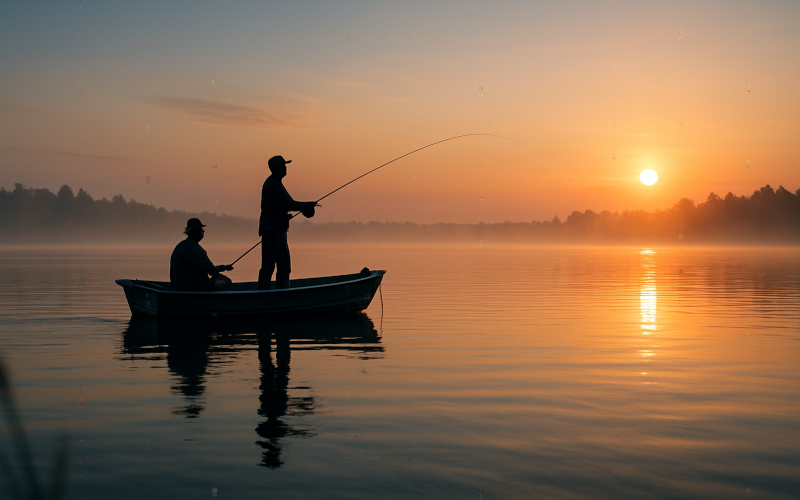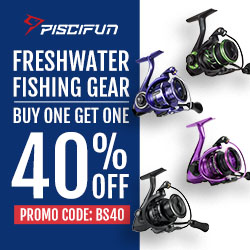Disclaimer: This post may have affiliate links. As an Amazon Associate, I earn from qualifying purchases.
Drift Fishing: Letting the Current Do the Work
September 23, 2025 - Reading time: 6 minutes
Master drift fishing in rivers, lakes, and saltwater. Learn rigs, gear, and pro tips to let the current present your bait naturally.

Some anglers fight the current. Smart anglers use it. Drift fishing is all about presenting your bait naturally by letting it move with the flow of water whether it’s a river current, wind-driven drift on a lake, or tide pulling through a channel. Done right, it’s one of the most effective ways to put your bait where fish expect it.
Why Drift Fishing Works
Fish are conditioned to watch the flow. Food washes downstream, across flats, or along drop-offs. By drifting, your bait looks like the real deal: effortless, natural, and perfectly in sync with the environment.
Drift fishing covers ground without spooking fish and keeps your lure in the strike zone longer than a stationary presentation.
Drift Fishing Basics
Step 1: Position Your Boat
-
In rivers: start upstream and let current carry you.
-
In lakes: use the wind to drift across productive areas.
-
In saltwater: tides do the heavy lifting.
Step 2: Choose the Right Rig
-
Bottom Rig: Weight + baited hook (great for catfish, walleye, or bottom feeders).
-
Drift Floats: Keep bait suspended off bottom for trout, bass, or panfish.
-
Drift Socks: Slow your drift speed in windy lakes for better control.
Step 3: Control the Speed
-
Too fast = bait looks unnatural.
-
Too slow = you won’t cover enough ground.
Popular Drift Fishing Rigs
-
Carolina Rig: Sliding sinker above a swivel and leader. Keeps bait close to bottom but still moves naturally.
-
Slip Float Rig: Adjustable depth, perfect for drifting live bait or jigs in rivers.
-
Three-Way Rig: Excellent for controlling depth when fish are suspended.
Drift Fishing in Different Waters
-
Rivers: Drift through pools and runs where fish wait for food.
-
Lakes: Use wind drifts over humps, drop-offs, and weed edges.
-
Saltwater: Drift along reefs, flats, or channels with cut bait or live shrimp.
Gear That Helps With Drift Fishing
-
Rods: Medium to medium-heavy rods with sensitive tips.
-
Reels: Spinning reels for light rigs; baitcasters for heavier rigs.
-
Line: Braid for sensitivity, fluorocarbon leaders for stealth.
-
Extras: Drift socks, anchors, and electronics for boat control.
👉 BEST SELLER | 20% OFF BIG DEAL – This drift-ready combo makes controlling line and detecting bites easy, even in tough currents.
Pro Tips for Drift Fishing Success
-
Stay Vertical: Keep line as vertical as possible for best control.
-
Adjust Weight Constantly: Use just enough weight to keep contact with bottom.
-
Read the Current: Fish often sit behind boulders, logs, or breaks waiting for food.
-
Use Electronics: Spot drop-offs, bait schools, and depth changes to maximize drifts.
Common Mistakes
-
Drifting too fast (use a sock or motor to slow down).
-
Letting too much slack line out, you’ll miss strikes.
-
Using too heavy a weight, bait drags unnaturally.
Drift fishing is as close as it gets to “fishing on autopilot” but don’t mistake it for laziness. It’s a skill, a balance between letting nature move your bait and keeping just enough control to stay in the strike zone.
Next time you’re on a river, lake, or coastal flat, stop fighting the current. Drift with it and watch your hookup rate climb.
Hunting & Fishing Life - All-season outdoors living, guides, and gear reviews.
HookdLife - Outdoor stories, gear talk, and the hooked life culture.
Country Redneck - Country grit, humor, and real-life outdoor living.
Coffee & Grits - Southern mornings, hard work, and good coffee.
WolvesTale - Frontier tales and wilderness fiction inspired by the wild.
MTDLN Media Group - Explore our full outdoors and storytelling network.
